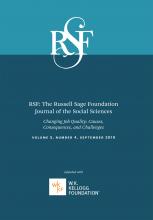Research Article
Open Access
The Changing Quality of Nonstandard Work Arrangements: Does Skill Matter?
Cathy Yang Liu, Luísa Nazareno
RSF: The Russell Sage Foundation Journal of the Social Sciences September 2019, 5 (4) 104-128; DOI: https://doi.org/10.7758/RSF.2019.5.4.04
Cathy Yang Liu
aProfessor of public policy at Andrew Young School of Policy Studies, Georgia State University
Luísa Nazareno
bA PhD student of public policy at Andrew Young School of Policy Studies, Georgia State University

References
- ↵
- Abraham, Katharine G,
- John C. Haltiwanger,
- Kristin Sandusky, and
- James R Spletzer
- ↵
- Acemoglu, Daron, and
- David Autor
- ↵
- Autor, David
- ↵
- ↵
- Autor, David H.,
- Frank Levy, and
- Richard J. Murnane
- ↵
- Becker, Gary S
- ↵
- Bernhardt, Annette,
- Rosemary Batt,
- Susan Houseman, and
- Eileen Appelbaum
- ↵
- Bertrand, Marianne,
- Claudia Goldin, and
- Lawrence F. Katz
- ↵
- Blau, Francine D., and
- Lawrence M. Kahn
- ↵
- Bureau of Labor Statistics (BLS)
- ↵
- Carnoy, Martin,
- Manuel Castells, and
- Chris Benner
- ↵
- Catanzarite, Lisa
- ↵
- ↵
- Donovan, Sarah A,
- David H Bradley, and
- Jon O. Shimabukuro
- ↵
- ↵
- ↵
- Farrell, Diana, and
- Fiona Greig
- ↵
- Farrell, Diana, and
- Fiona Greig
- ↵
- Fischer, Claude S., and
- Michael Hout
- ↵
- ↵
- ↵
- ↵
- ↵
- Harris, Seth D., and
- Alan B. Krueger
- ↵
- Hippel, Courtney von,
- Venkat Bendapudi,
- Judith Tansky,
- David B. Greenberger,
- Stephen L. Mangum, and
- Robert L. Heneman
- ↵
- Holzer, Harry J
- ↵
- Holzer, Harry J.,
- Julia I. Lane,
- David B. Rosenblum, and
- Frederik Andersson
- ↵
- ↵
- Jaimovich, Nir, and
- Henry E. Siu
- ↵
- Kalleberg, Arne L
- ↵
- ↵
- Kalleberg, Arne L
- ↵
- Kalleberg, Arne L
- ↵
- Kalleberg, Arne L
- ↵
- Kalleberg, Arne L.,
- Barbara F. Reskin, and
- Ken Hudson
- ↵
- Katz, Lawrence F., and
- Alan B. Krueger
- ↵
- Lemieux, Thomas
- ↵
- ↵
- McKinsey & Company
- ↵
- Polivka, Anne E
- ↵
- Polivka, Anne E., and
- Thomas Nardone
- ↵
- Schmitt, John
- ↵
- Spletzer, James R., and
- Elizabeth W. Handwerker
- ↵
- ↵
- ↵
- ↵
- Weil, David
In this issue
The Changing Quality of Nonstandard Work Arrangements: Does Skill Matter?
Cathy Yang Liu, Luísa Nazareno
RSF: The Russell Sage Foundation Journal of the Social Sciences Sep 2019, 5 (4) 104-128; DOI: 10.7758/RSF.2019.5.4.04
Jump to section
Related Articles
- No related articles found.
Cited By...
- No citing articles found.





